Paintbrushes: Exploring synthetics Part 2
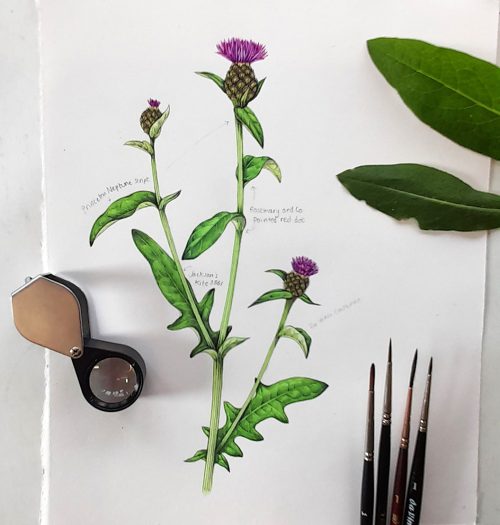
This blog is a follow up to one I wrote a while ago on Paintbrushes, and accompanies the series I’ve done on art equipment. There’s an accompanying Youtube film showing me trialling these four synthetic brushes.
In my last blog (and accompanying Youtube film review of brushes ), I ended up recommending Rosemary and Co. Spotter Red Dot. But since then I’ve painted almost exclusively with my beloved pure sable Winsor and Newton series 7 sable paintbrushes .
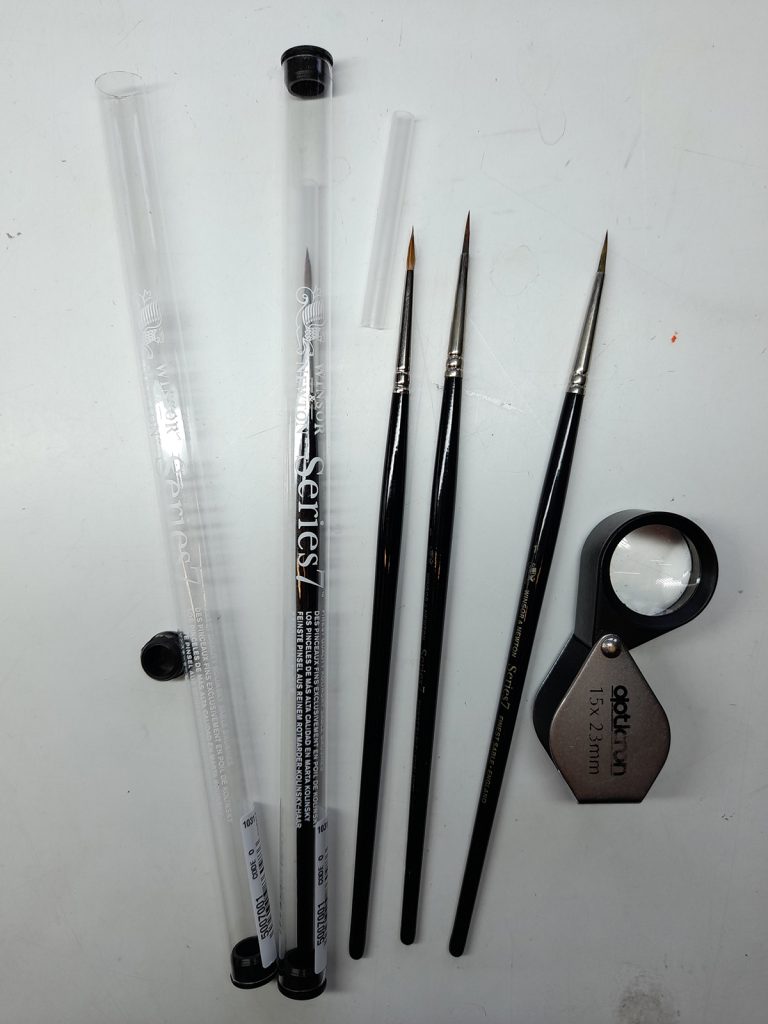
Winsor & Newton Series 7 brushes with hand lens
Sable
Sable brushes are not, in fact, made form the hair of the Sable. These creatures live in Larch woods, and are a type of marten, latin name Martes zibellina. No. The sable used to make watercolour brushes comes from the Kolonok, or Siberian weasel Mustela sibirica.
As a life-long vegetarian, I survived for many years without even thinking properly about the link between animal welfare and my paintbrushes. But following from a chance remark on one of my Youtube videos, I decided to look for synthetics instead. These weasels are voracious predators of rats and other vermin, but can also be pests to poultry farmers. Their fur has long been used to make brushes for artists and calligraphers. But I think I should try to move away from Kolinsky sable brushes if I can.
What other synthetic options are out there? Recommendations and suggestions have come in thick and fast since then, and I’ve managed to get my hands on some of these brushes, and tested them.
The set-up
I need to illustrate the Common Knapweed, Centaurea nigra subspecies nigra. As before, I’ll use a different test brush on different leaves. And hope for the best!
I’m working on Fluid 100 hot press watercolour paper.
In all cases, I test a size 1 brush. This is my default brush size and is perfect for my botanical illustration and natural history work. I’ve ordered all these brushes (except the Rosemary red Dots) through Jackson’s art, a UK based art materials shop. It should also be pointed out that I haven’t been asked or paid to review any of these brushes, so (hopefully) that makes my reviews un-biased.
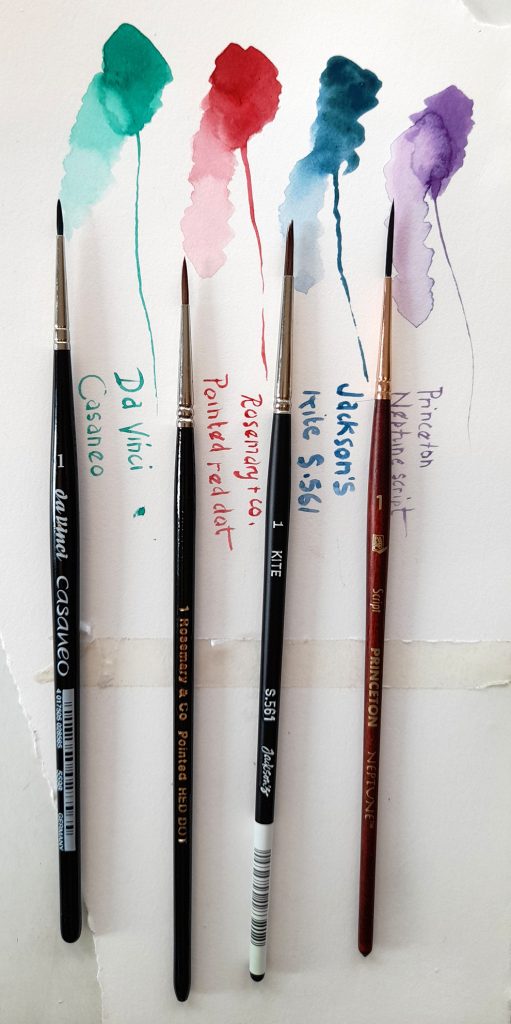
Here are the four brushes I’m reviewing. Left to right: Da Vinci Casaneo, Rosemary & Co Red dot Pointed, Jackson’s Kite S561 and Princeton’s Neptune Script. Links to all brushes in the text below.
The price I use for my Series 7 number 1 is a full discount price, not the full retail price of £17. 10 (2021 price). And these prices fluctuate a lot, with the brushes sometimes being as little as £5.80 each.
Princeton Neptune script
The first synthetic I’m trying is the Princeton Neptune script. This is a synthetic squirrel, rather than a synthetic sable.
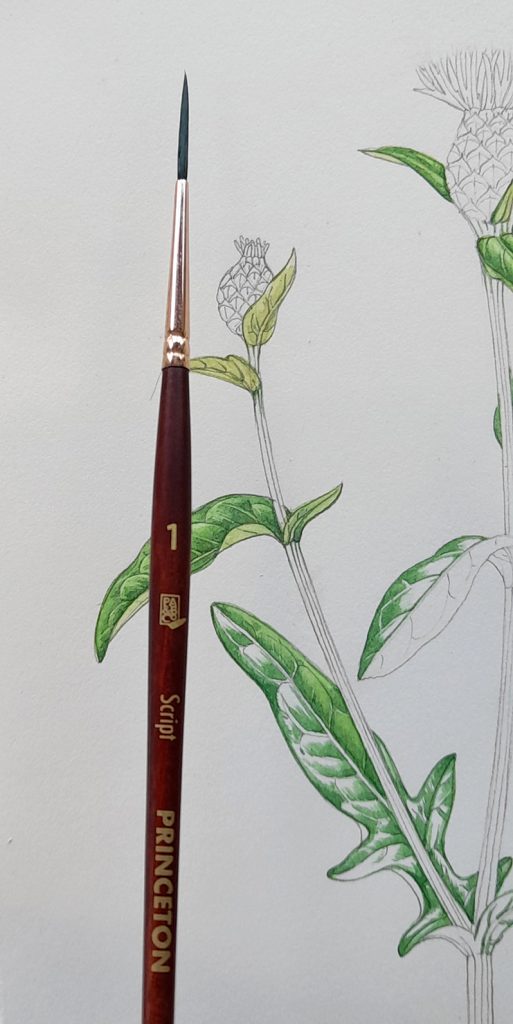
Princeton Neptune Script
First sight is alarming. It has an extremely long point, longer than any brush I’ve worked with before. Somewhere in the back of my mind the term “rigger” springs to mind. Is this the correct name for these long, fine-tipped brushes? After a little internet trawling it seems my hunch is right. Click here for more on rigger brushes, and how to use them.
However, despite my misgivings, on taking off the cover and using it I’m pleasantly surprised.
The tip is extremely fine, and doesn’t degrade or blunt at all for the whole time I use it. The synthetic squirrel holds a lot of paint, so you don’t need to keep refilling the brush. Thin lines build up next to one another without merging. Crisp edges are easy. Thin defining lines aren’t at all problematic. This brush is great!
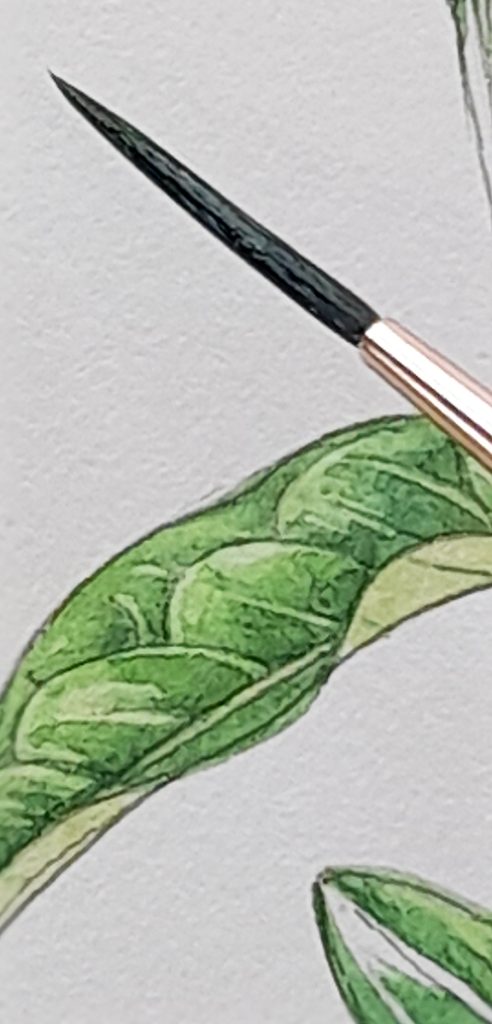
Princeton Neptune Script with leaf painted with the brush behind
My problem is the feel of such a long point. This is pronounced when I’m mixing colours. (Please don’t tell me to have a special rubbish-y brush for colour mixing. I know I should do, but when I’m working to dead-line I just don’t have time to keep switching brushes!) Saying that, if you have a slightly more leisurely approach to your watercolour painting, it’s a great idea. Nothing trashes brushes faster than mixing colour with them).
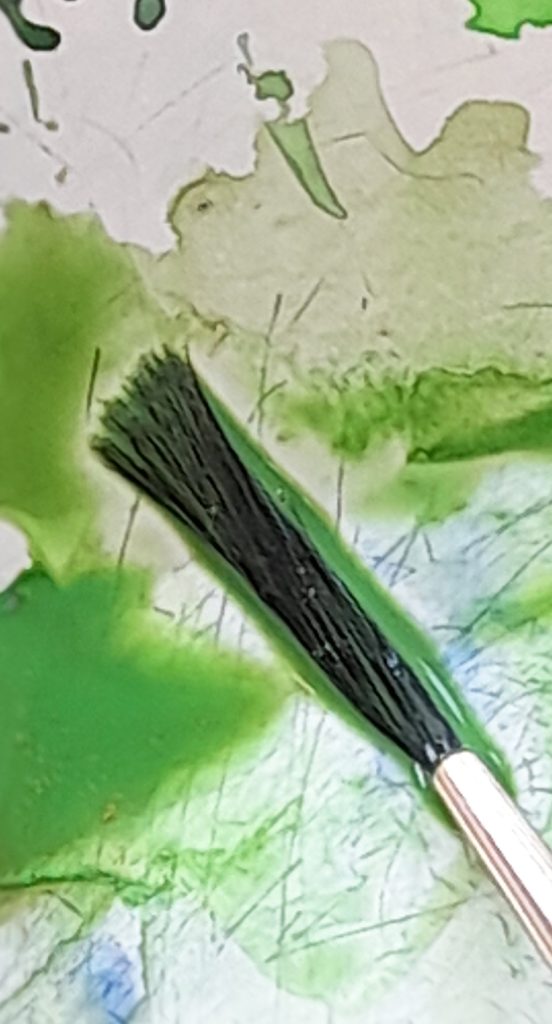
Mixing colour with the Princeton Neptune Script
The action of the brush on the page is lovely.
Because the tip is so very fine, perhaps it takes a little longer to build up areas of colour, and to my eye they look a little washed out when I’m done. Perhaps because each line is so very thin you do actually end up with less pigment on the page?
But for crisp detail, the Princeton Neptune Script is great.
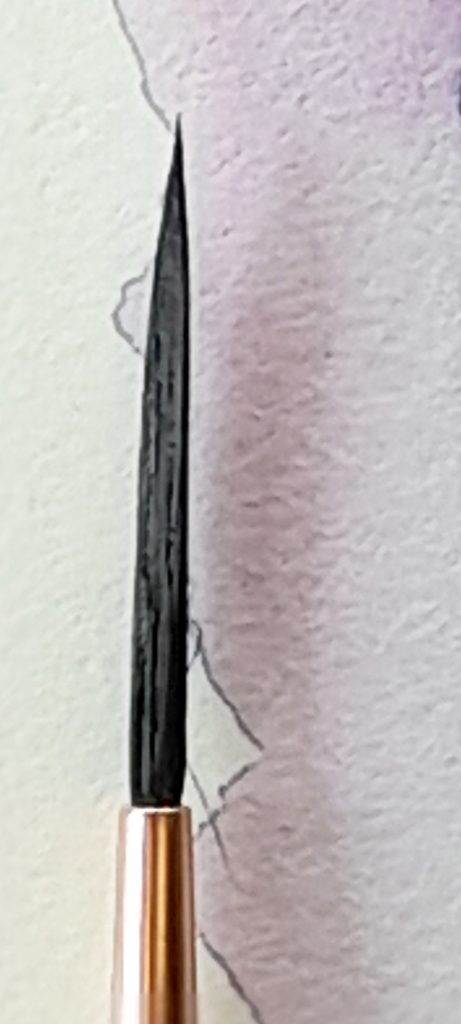
Close up of the tip of the Princeton Neptune Script brush
This brush retails at £4.90 – £6.10. My regular Series 7 no. 1 size brush retails (with a hefty discount) at £5.80, so this one is slightly cheaper.
Kite S561 by Jackson’s
This was the most expensive of the brushes I tested. It’s a synthetic sable and cost more than my Series 7 brush (£10.30), so I was expecting good things.
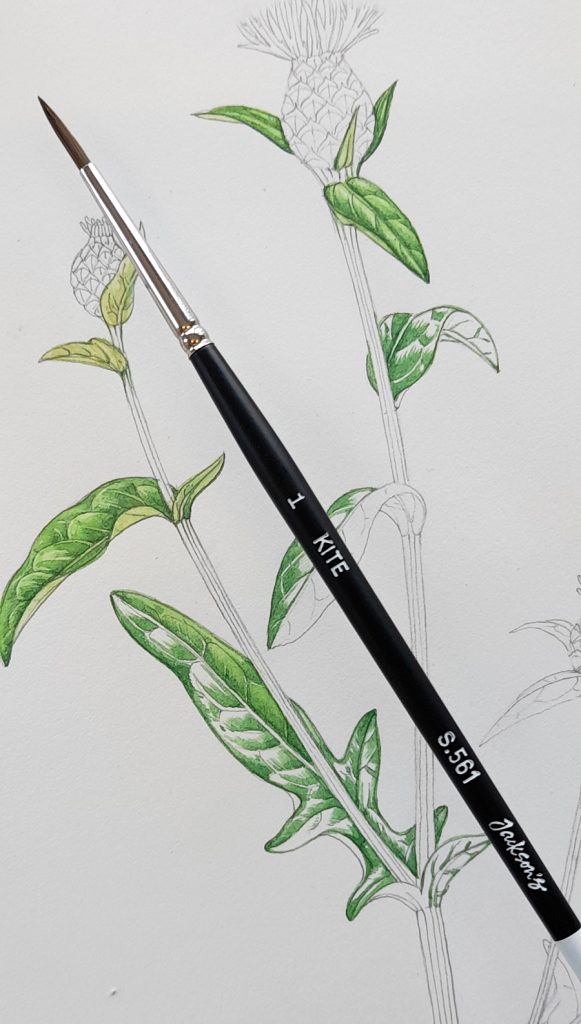
Jackson’s Kite S.561
Imagine my surprise when the Kite S561 simply didn’t work out that way. The tip of the brush is ragged, and blunt. It has a slight hook. In the hand, it feels the same shape and weight as a Series 7, but it’s not performing like one.
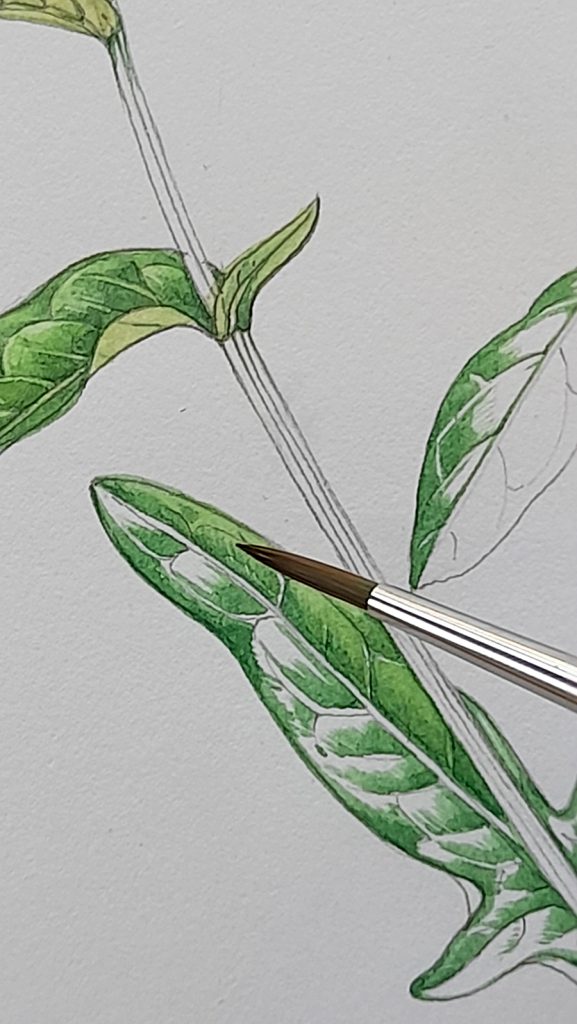
Jackson’s Kite S.561. Looks perfect but somehow…isn’t. The right had side of the leaf behind has been painted with this one.
The lines it leaves are thick and unpredictable. No matter how I twist the brush in the paint to “sharpen” it to a point, it remains blunt. In fact, I have to stop using it as it’s compromising the Knapweed illustration.
I’m disappointed. It could be a dud brush. But for the high price, I would have expected something far better, especially when the other synthetics on the market are priced so much more competitively.
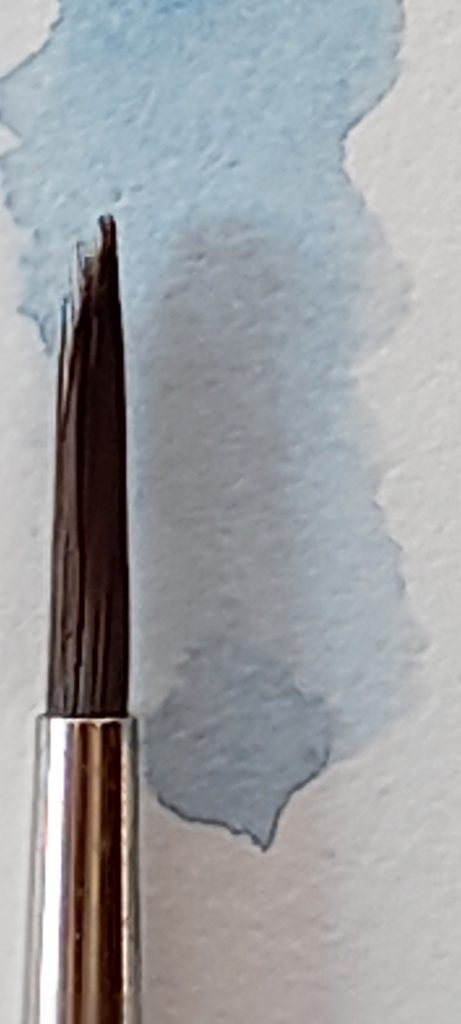
Close up of the tip of the Jackson’s Kite S.561 brush
Rosemary and Company Pointed Red Dot
I’m feeling optimistic with these Red Dot brushes, brought direct from the company (Rosemary and Company) Not only do they come recommended by the excellent botanical illustrator Polly O’Leary, but they’re the sister product to the Red Dot spotters that I reviewed and liked most in my last blog. They’re synthetic sable.
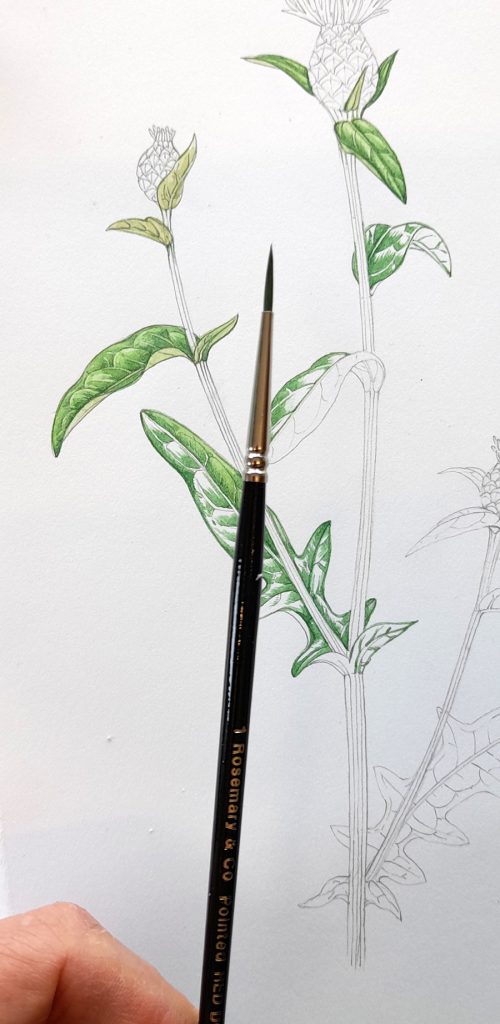
Rosemary & Co Red Dot Pointed brush
Initial feelings are fabulous. The brush looks and feels a lot like my Series 7. It has plenty of bulk to hold paint, and the point is tiny and crisp. This remains undamaged by mixing paint. Each brush-stroke delivers a little more than the Neptune script, so the colour builds up swifter and more saturated. So far so good.
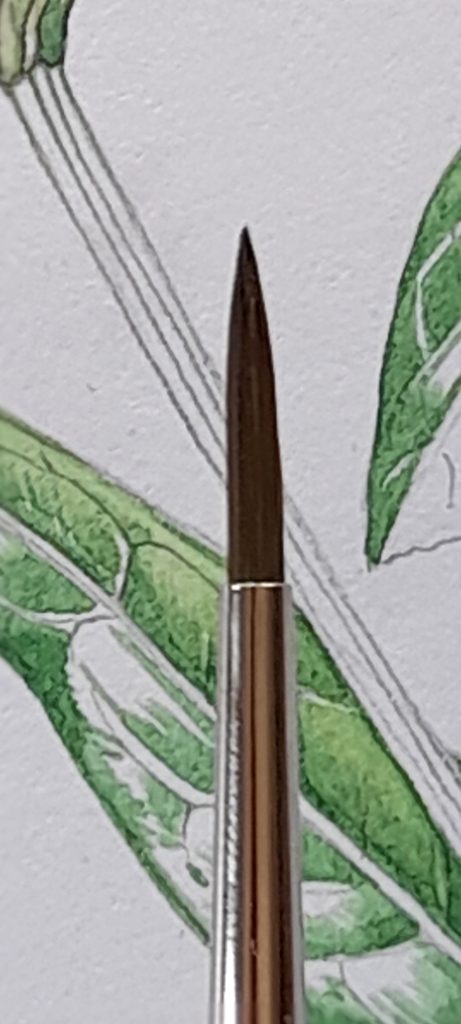
Close up of the Rosemary & Co Red dot Pointed with leaf painted with it behind
Then, after about 10 minutes, the brush starts to change. The tip loses its definition. I feel almost like the barrel of the brush swells, and seems to hang really low behind the tip, threatening to leave extra unwanted brush marks.
On the plus side, the “barrel” or well holds a lot of paint, so I don’t need to keep going back to my paint-box to top up on paint. The tip doesn’t become completely compromised, it’s still pretty sharp.
It’s not a disaster, but it’s certainly no longer nearly as good as when I first used it. And less enjoyable than the the Red Dot Spotter. But like I say, I know a lot of excellent botanical illustrators swear by these brushes. I don’t want to be too hasty in writing them off.
Price wise it only costs £2.75 though. So perhaps I was unlucky and had a “bad brush”. These things happen.
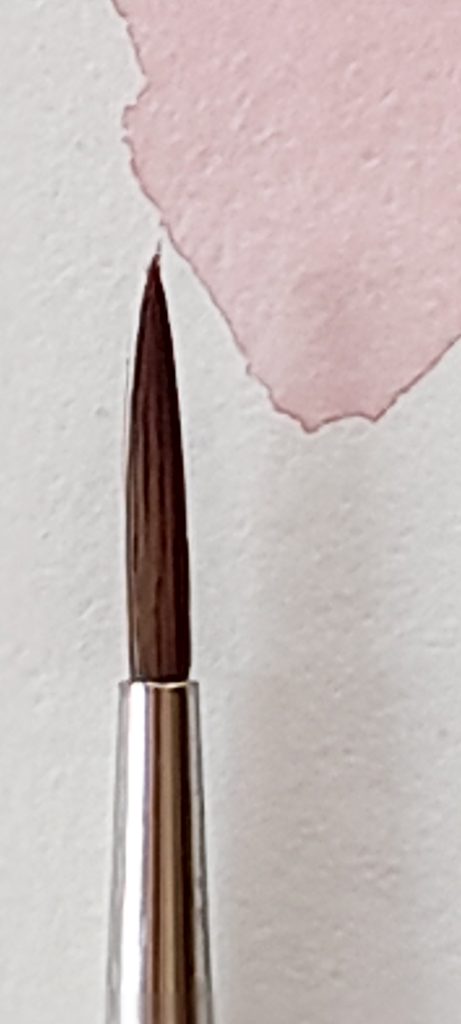
Close up of the tip of the Rosemary & Co Red Dot pointed brush
Da Vinci Casaneo 5598 Round
The Da Vinci is another synthetic squirrel, this time a Kazan squirrel. I had to look up “Kazan squirrel”. It seems to be a normal squirrel (although whether Red or Grey I couldn’t establish) from the Kazan region of Russia. So we continue. Anyway, it’s another synthetic.
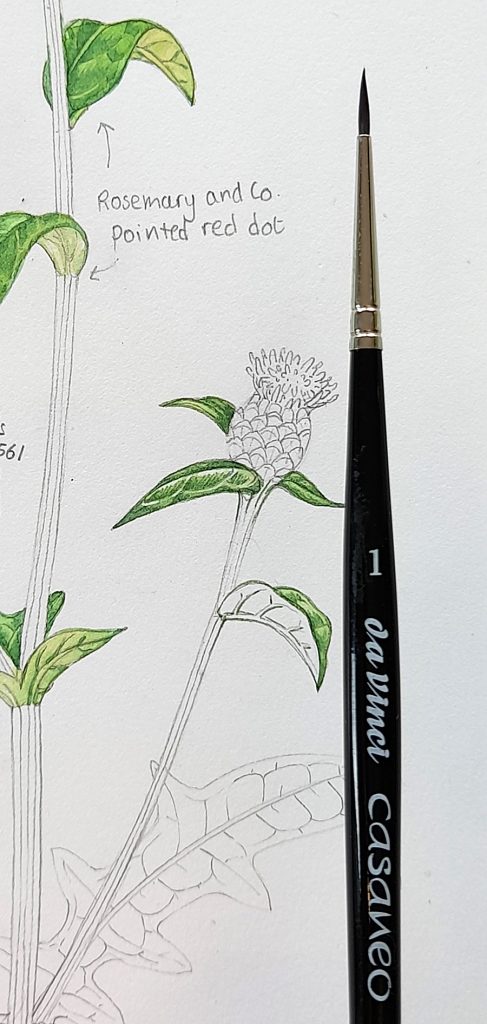
Da Vinci Casaneo brush with leaves painted with it behind and below
My initial response to this was not brilliant. The brush had a tiny hook at the tip. Not enough to make it un-useable, but not a good start.
I’d forgotten the useful tip I’ve been given about removing hooks from the tips of synthetic brushes:
It has come in from Rebecca, who left this suggestion in the comments section of my last watercolour brush blog . “Hooks that develop on synthetic bristles can often be remedied by dipping the bristles about half way into a cup of water taken off the boil. Take care not to get the ferrule or upper bristles wet with water this hot or it may affect the glue. The timing varies from 10-30 seconds based on the brand and size. Gently reshape the tip on your thumbnail after heating. While I don’t expect that is an annoyance one would want to deal with during a long painting session, it will at least restore the brush to a usable condition for lighter tasks.”
I started using the brush and it’s fine. The hook hasn’t thickened the line width, and the point remains tight.
After a few minutes though, it seems to develop some sort of lateral compression. The brush looks as if someone has squeezed it between thumb and finger. This leaves me feeling nervous. It feels like the brush could do something unexpected at any point, being this odd shape and with the little hook.
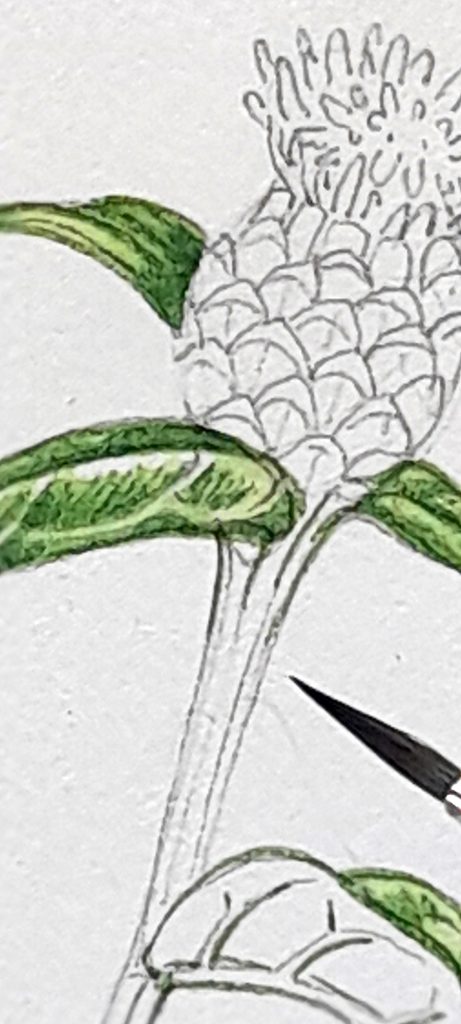
Nib of the Da Vinci Casaneo brush, showing the odd “compressed” effect
Although is paints perfectly well, the ominous feeling that it’s all about to go wrong doesn’t lift. I feel like I’m about to screw up the illustration at any point. I can’t relax into painting, but am hyper-vigilant, checking every stroke. This is no way to paint.
Because of this, even though the performance is better than all but the Princeton Neptune, I turn from the Da Vinci Casaneo.
Again, it could be a bad brush. Or just one that’s not perfect. Which, for someone who is as tough as a critic as I am, is basically the same thing.
It’s a shame. With a price point of £6.30, they’re not much more expensive than the price of my (discounted) Series 7 brushes. But are less reliable.
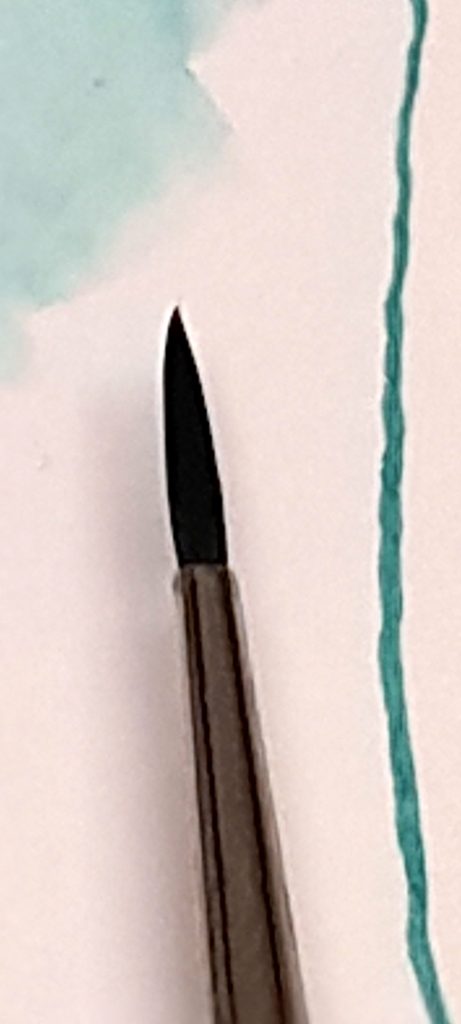
Close up of the nib of the Da Vinci Casaneo brush
Synthetics: Conclusion
Having tried all four brushes, I’m afraid none match my Series 7. Is this because it’s what I’m used to? Or because it’s a superior product? It’s hard to tell.
However, if I were to explore these synthetics further, I’d be focussing in on the Rosemary and Company Red dot range. I truly feel there will be a brush in there that suits me and my approach to painting. They’re cheap, and have lovely points. And although they seem to degrade quickly, I feel there’s scope for me to use them more before writing them off.
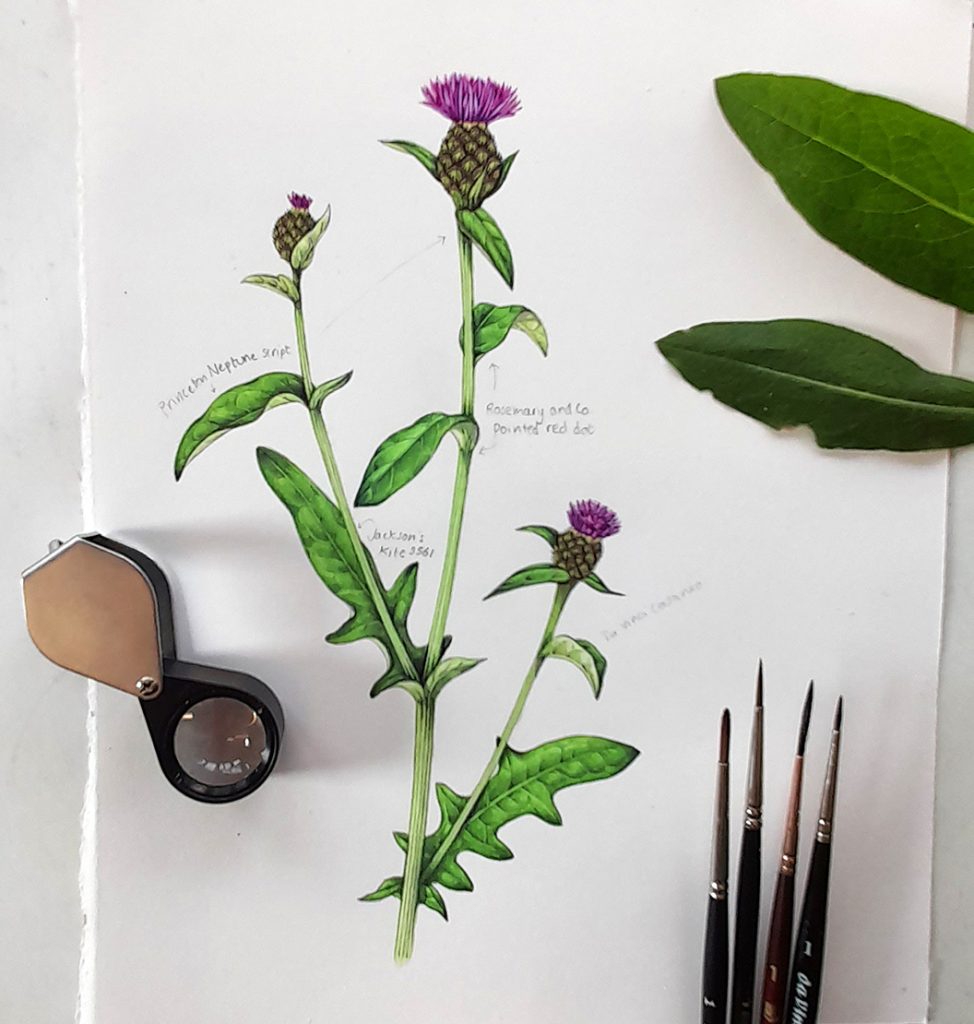
I did think the Princeton Neptune Script brush was brilliant, and held its point wonderfully. It’d be superb for doing tiny long hairs, say on the stem of a Wood rush Luzula sylvatica. But I just don’t think I can get used to wielding a brush that long. It feels too weird. I’m a creature of habit, and habit calls for a shorter, stouter brush. But they’re well worth a try if you’re less stuck in your ways than I am. In terms of getting detail and during the actual act of painting, the Neptune was my favourite out of these four brushes.
And here ends my exploration of synthetic brushes. There are many more brands out there, but I think I’m finished exploring. I’ll stick to a more detailed investigation of the Rosemary and Co brushes. I might play around with the Princeton Neptune and see if I can get used to such a long tip, and keep my fingers that I find the perfect solution soon. Only then will I be able to look at a weasel full in the face again.

Weasel Mustela nivalis (NOT the Siberian weasel, but a cousin)
For a lot more detail on this set of comparisons, please check out my Youtube video (or see it, below), and don’t forget to refer back to my other earlier review of synthetic brushes, both in blog form , and as a Youtube film.
Although I don’t plan on reviewing any more synthetics, please do put suggestions as to which you favour or have tried in the comments section below. I like the idea of these blogs and films being a good reference point for people on a similar journey, questing for the perfect synthetic brush.
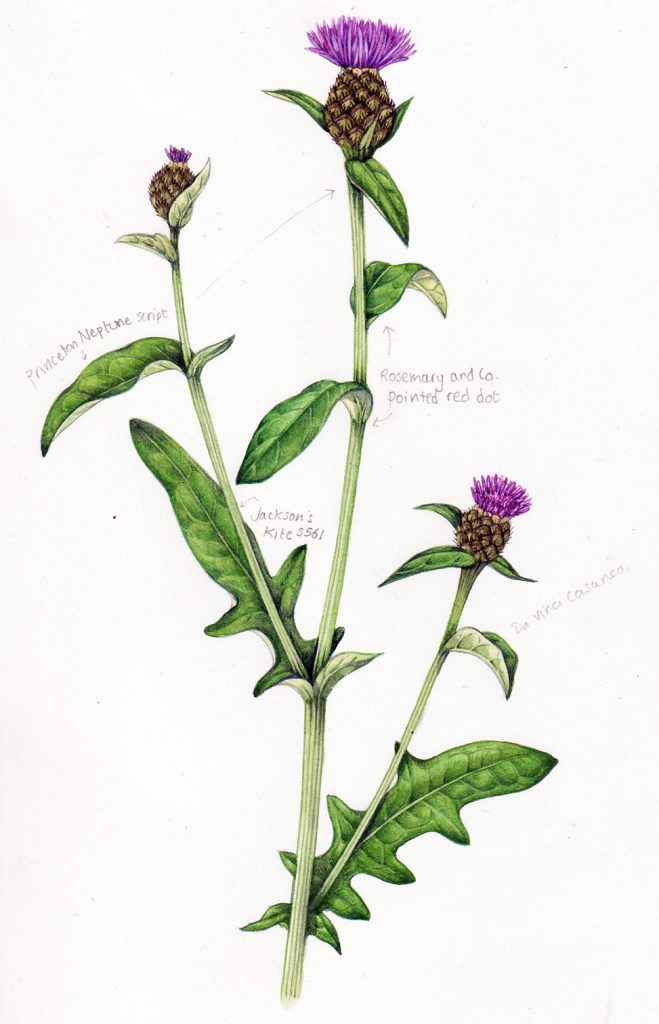
Annotated Illustration of Common or Black knapweed showing which leaves were done with which brush


Good morning Lizzie. The problem appears to me that over the last couple of hundred years artists have by trial and error found for more detailed work that Kolinsky Sable hair works. To break this history and find a synthetic equivalent could take a good many years in itself.
We as humans also have our preferred methods and I find anything that varies from the Series 7 is not to the levels I set myself, but never give the synthetic brush a long enough trial to give a really reasoned response, which is an admission that I am failing the synthetic and not giving it a fair chance.
I hope this finds you well and in good spirits.
Regards Peter
Hi Peter
Agree entirely with every word of your comment. Yes, I also feel Im not giving the synthetics a good enough try. And someone has also pointed out that violently mixing my colours will degrade these brushes super-fast which is another thing I’d not considered. Ho hum. So do I go on striving for a good synthetic, or resign myself to a life of feeling slightly guilt about weasel tails for all time. I happen to have a dead weasel in the freezer (thanks to my aunt’s cat) – perhaps I should try to make my own? (The mind boggles) Thanks for the comment Peter. x
I came to post here the links towards the brushes that I’ve suggested on your youtube video because youtube does’t allow me to post links.
Here are my suggestions.
Tintoretto S595
https://www.tintorettopennelli.com/en/thin-synthetic-sh/
Tintoretto 450
https://www.tintorettopennelli.com/en/bronze-synthetic-sh/
And Escoda WHITE TORAY SYNTHETIC | SHORT ROUND POINTED
https://www.escoda.com/round-wh-toray-synth-short-s-h.html
Check if any of them works for you.
Kisses and hugs
Marialena
Lovely Marialena, what excellent suggestions. I have added them and your links to the blurb under the youtube video where I suggest other brands to try. Thankyou xxx
Thank you, thank you!! 🙂 🙂 🙂 Youtube’s always confusing me. I never know what can I post there or not.
May I make another suggestion that it is a bit different but you might like it.
Pentel aquash waterbrush size Fine.
These are the brushes that have a water reservoir at their handle. The Fine one is super pointy and it has very good snap and due to its reservoir it has also a constant but controlled by you flow of water.
Waterbrushes as they are called, work differently than the regular brushes.
Instead of adding water to the brush you remove it by drying the brush on a towel because the clean water is in the reservoir in the handle of the brush.
But this is easier than dipping constantly the brush into clean water and trying to figure out how wet you want the bristles. The brush can’t be damaged so easily because its bristles are constantly wet ( and if you squeeze the reservoir even wetter) and so it is very easy to load them from your paint pans and then mix the colours.
And the fine ones are very pointy. This is one of mine and it is already heavily used. I have to replace it but anyway.. check how pointy still is.
https://ibb.co/gmqQBX1
I personally use them along with a water container like the classic brushes ( this is my trick) in order to wash the paint out faster and retain their bristles pointy for longer. I wash out the paint in the classic water container and I use the clean water that is in the brush reservoir to dilute and mix clean colour. Then I bring the wetness of the brush to the level that I want, by squeezing the reservoir or drying the brush on a towel and then I paint. If I want less flow I leave it’s reservoir half empty.
I don’t know if you will eventually like them. Some people can’t figure out how to use them as it needs a bit of practice on how to regulate the flow from the reservoir – you squeeze the reservoir gently, but if you use them for a while you are going to see how convenient they are. It is not like having to learn everything from scratch.
And they are affordable,( the fine one costs here 4 euros) replaceable, ( I buy them in bulk) and vegan friendly. When they eventually die out you throw them at the recycling bin.
And another tip. These brushes are not to be used with the Zig Kuretake white ink because this acrylic ink can clog the holes that feed with water their bristles.
Use a regular brush with the Zig ink if you end up using the pentel waterbrushes.
But do give them a try. 🙂
Marialena, this is another excellent suggestion. Someone lent me one of these brushes once and I didnt get on with it – but then I didnt use it for long so probably didnt really give it a chance. Interesting that you enjoy them, and that’s a good reason to consider trying them again. Thankyou. I do use that Zig white ink for touching up mistakes, along with the white gouache. Thankyou. And you can leave comments here or on youtube -I do get them on youtube although sometimes replies to may replies eem to get lost….but either is fine. And both are much appreciated!
Check these too:
https://www.rosemaryandco.com/series-402-pointed-sable-mixture
They are blend brushes ( half synthetic half sable) and if you want the exact same size with the W&N Series 7 no1 then buy from this brushes the no0
Good morning Lizzie and Marialena
If I might add to this interesting conversation, I have the Derwent water pens but could not get on with them, then discovered they were fantastic for placing and mixing paint on your palette especially as you have a water source in the handle.
This had the added bonus of you not having to “knock the bottom end” out of one of your reasonable condition brushes. I gave the water brush (as a paint brush) a chance but for some reason could not control so well on the paper.
Is it not great that the community on here are happy to bounce ideas and suggestions around without causing offence.
Marialena, those Series 402 from Rosemary look interesting might be adding a brush or two soon.
Am I the only one looking for brush utopia?
Regards and best wishes to you both.
Hi Peter,
I haven’t used the Derwent waterbrushes to have an opinion but the Pentel changed the game for me.
Waterbrushes are different and you need to use them for a while in order to figure out how they work.
The thing that needs a bit of practice is to learn when and how to squeeze them ha ha ha which means the way you hold them, in order to make them do what you want them to do. If you want more flow you have to hold them from the reservoir. If you want less flow and more detail you have to hold them closer to the bristles. When you squeeze the reservoir you increase the flow.
I suggested the waterbrushes to Lizzie because Lizzie is using her brushes to actually draw with the watercolours, and that is the reason why she likes the very pointy ones. Lizzie also holds the brush very close to the bristles so technically she would be able to paint with watercolour markers too.
I suggested the Rosemary 402 because I like the pointy and somewhat conical shaped brushes.
In the Japanese style or the ultra round ones that have longer bristles, conical shape and are very pointy. My favourite ones were the Loew Cornell Ultra Round but unfortunately they were discontinued.
The W&N though they are great they are out of touch, because they are very expensive and very difficult to find here in Greece. They are almost permanently out of stock. This doesn’t work for me. I mean to afraid to use my brushes because I’m afraid that I’ll be not able to replace them. I’ve been left with a no1 that is now my precious.
You are not the only one who is looking for brush utopia. It is a common ….disorder among artists! lol Along with the paper and paints utopias. ha ha haaaaaa
Good morning Marialena
I hope this finds you in good health and in fine weather in Greece. Having now looked at your website I must admit that I am very impressed by your waterbrush control and your mini 30 colour palette.
The Galanthus painting has wonderful tone too it.
Do you mind if I stay in touch through your blog occasionally as you have inspired me to give the waterbrushes another go for a longer period.
Regards Peter
This is fabulous! And I couldnt agree more Peter – isn’t MNarielena’s work stunning? Glad she’s inspired you to try again with the squeezy brushes
Ah Marielena, you are fabulous! You’re like the brush-doctor or psychiatrist. I love the analysis that goes into your suggestions. And like I say, I think youre right about the squeeze ones – I think its me not having given them a chance. But Im v tempted to buy in a couple of those Rosemary brushes…. xxxx
Hi Peter
yes, Ive struggled with the brushes that hold water too. But I think its likely to be me at fault, or just not used to using them. So glad you like the open suggestions and chat, its precisely why I write the blog and I love how many fab suggestions come in!
Thanks Marielena. getting the sizes right is tricky, so this is very helpful x
Yes of course. Though I don’t update very often my blog because currently I’m running after exhibitions.
But if you like you can send me an email too. Don’t get discourage by the form thing at my website. I had to install it everywhere to stop spamming that has destroyed all discussions.
I’m going to update my botanical page soon because this winter I practiced a lot. I’m determined to improve! 🙂
The mini colour palette is not particularly convenient. What I ended up using the most is the wooden box that I bought from the S. Korean guy on Etsy. This is great for botanicals. And I’ve changed my colour selection to mostly primaries and this winter I’ve made my own watercolours too.
The problem is that I don’t update that often my blog. Shame on me.
P.S. Where is Lizzie??
Hi Marielena (and Peter)
Ive been on holiday for a week, and come back to see this blog buzzing with brush suggestions and cross-pollination of ideas. It’s perfect. I had no idea you MADE your own paints? How wonderful! I read a fabulous book recently all about colour through history, it was called “Colour” by Victoria Finlay and had a lot about pigments and how artists made their colours in the past etc. Fascinating.
Cheers marialena
X
Happy Easter!
I hope you had a great time in your holiday! 🙂 🙂
It is very easy to make your own watercolours and you can find fantastic colours as raw pigments that you probably didn’t even know that they existed. And it doesn’t worth to buy as ready made the colours that you use the most because the same colours in pigment form are very cheap. French Ultramarine f.e costs here 3 euros per 150grams. With 150 gr of raw pigment that you can make it yourself into watercolour you will probably have a supply of tubes and pans for the next five years.
I have read this book and it is a great read because Finlay traveled to all these places to get information for all these colours! She went to Afghanistan to find Lapis to Mexico cochineal , to India to find how Aureolin was made… It is not that she simply gives generic information about the pigments and the colours. Her book is like a travel journal! TBH I envied her for all these travels…! Ahhhh…
I have read this book and it is a great read because Finlay traveled to all these places to get information for all these colours!
It’s a stunner isnt it? She’s written a similar one on fabrics that I’ve not got round to reading yet. But it’s absolutely in the pile.
Good afternoon all, acquired the Victoria Finlay book on Kindle. An interesting and eye opening read which has, as you all say, made me think about the colour process and how I could utilise the process.
Having read the book now I feel I could comment, apologies for bringing up an older thread.
Regards Peter
Never apologise for that, Peter. And it doesnt feel old to me at all, we’re about to discuss it for next month’s book club! Im really glad you enjoyed it. She’s also done one on fabric which I plan to read too, at some point….